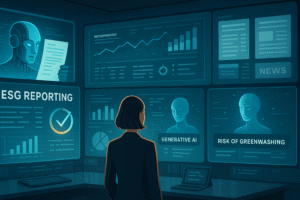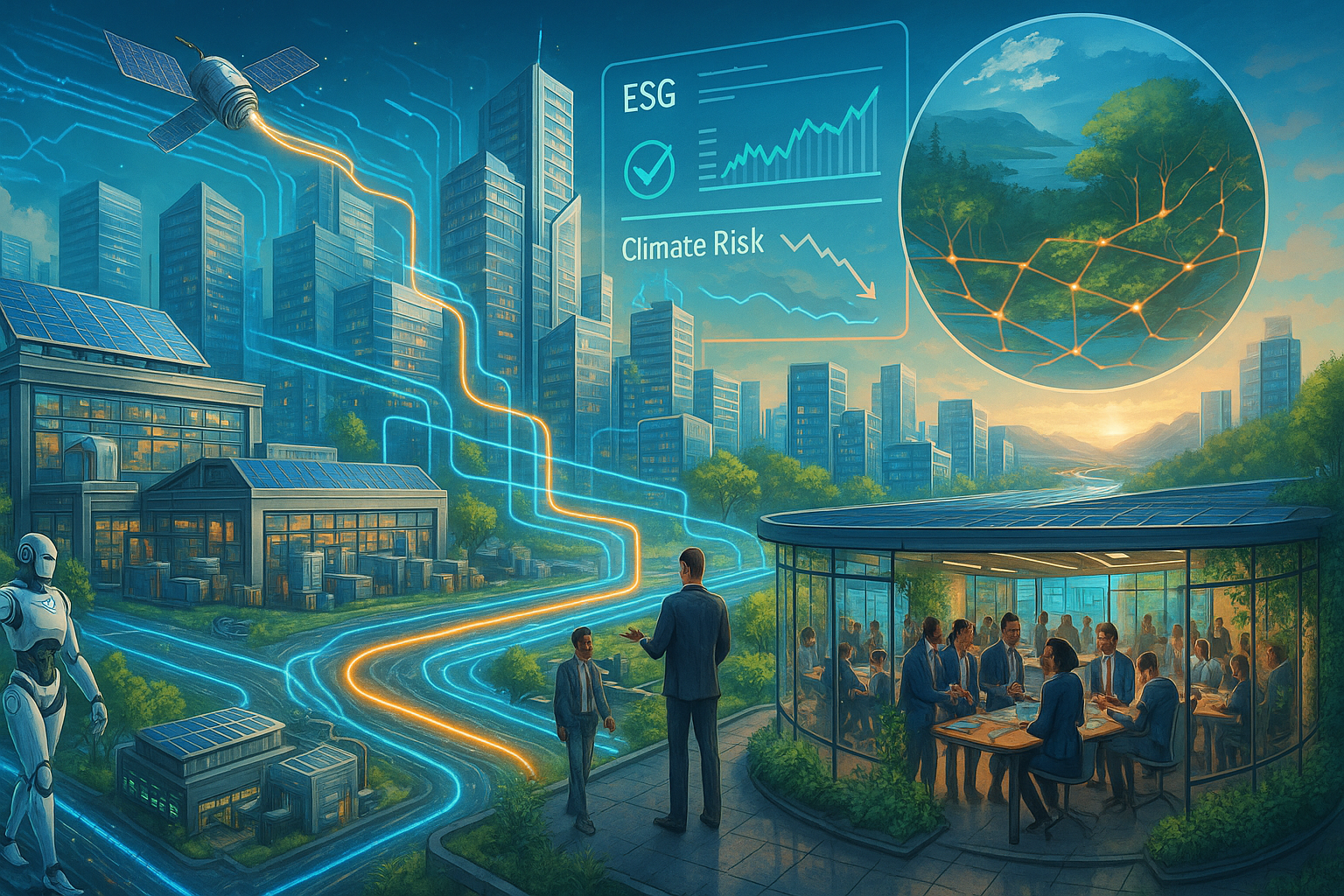The strategic imperative to fuse Artificial Intelligence (AI) with sustainability goals is reshaping how businesses operate and create value. Following our exploration of why this is critical, today we want to go into how AI is practically transforming sustainability efforts across the enterprise. A wide array of applications demonstrate AI isn’t just a theoretical tool but a tangible catalyst for
AI’s capabilities— machine learning (ML), natural language processing (NLP), computer vision, and generative AI (GenAI)—are being deployed across diverse business functions. This isn’t about isolated pilot projects; it’s about embedding intelligent solutions to drive measurable improvements in energy management, supply chain optimization, waste reduction, ESG reporting, climate risk assessment, and even in fostering social sustainability.
Mapping the Transformation: AI’s Key Application Areas in Sustainability
AI’s transformative power is also incredibly versatile. It can tackle sustainability challenges in a variety of application areas throughout an organization’s value chain. Let’s see some examples.
- Energy Management: AI is at the forefront of optimizing energy consumption across various domains. Smart building systems utilize AI to adjust heating, ventilation, and air conditioning (HVAC) and lighting based on occupancy and conditions, significantly reducing energy waste. Such systems can lead to 20-40% energy reduction in large EU buildings, and an average energy efficiency improvement of 15% is seen for companies using AI in sustainability initiatives. In energy-intensive data centers, AI optimizes cooling, with Google reportedly achieving up to 40% cooling energy reduction using DeepMind. Beyond consumption, AI enhances renewable energy efficiency by predicting wind patterns for turbine optimization and plays a crucial role in optimizing energy grids.
- Supply Chain Optimization: AI offers powerful tools for greening complex supply chains. AI-driven demand forecasting and inventory optimization minimize overproduction and waste. Route optimization algorithms for logistics reduce fuel consumption and emissions (Loeb, 2024). AI can also analyze vast datasets—such as satellite imagery and audit reports—to assess supplier risk related to ESG compliance, carbon emissions (supporting Scope 3 tracking), and labor practices (Mars, 2024). Notably, combining AI with blockchain enhances transparency and verifies ethical sourcing (AI in the Chain, 2024).
- Waste Management: AI improves the efficiency and effectiveness of waste handling. Computer vision enhances waste sorting accuracy for recycling (Envirocraft, 2024), while predictive maintenance keeps equipment operational and prevents costly breakdowns (MSR Cosmos, 2024). AI also optimizes waste collection routes and minimizes production waste by fine-tuning processes—leading to material waste reductions of up to 20% for companies integrating AI into sustainability efforts
- ESG Reporting and Compliance: AI is revolutionizing the often burdensome process of ESG reporting. It automates data collection from diverse internal and external sources, including unstructured formats like reports and news articles, thereby enhancing data accuracy, consistency, and timeliness. This significantly reduces manual effort and improves compliance efficiency. AI tools also monitor regulatory compliance and can even help identify potential greenwashing in corporate claims. Generative AI is emerging as a particularly transformative tool in ESG reporting and monitoring.
- Climate Risk and Environmental Monitoring: AI excels at analyzing complex environmental data, enabling the development of sophisticated climate models, predictive analytics, and risk assessments for business operations. Globally, AI is used to monitor deforestation (e.g., Indonesia’s satellite-based forest tracking), assess crop stressors (Ghana’s CADI AI project), and predict solar energy yields (Morocco’s Noor Ouarzazate Solar Complex). In Kenya and India, AI supports climate-resilient agriculture by optimizing planting schedules and diagnosing crop diseases. In South Africa, AI research aids decentralized energy and transport systems, aligning with the Just Transition framework. These applications illustrate how AI enables real-time monitoring of biodiversity, water and air quality, and sustainable resource use (UNFCCC, 2024).
- Sustainable Agriculture: AI enables precision agriculture, optimizing the use of water, fertilizers, and pesticides based on real-time data from sensors, drones, and satellites. This facilitates intelligent crop monitoring and soil quality assessment. Case studies show significant results, including increased crop yields (e.g., 15%) alongside reductions in operational costs (e.g., 12%) and resource waste (e.g., 25%).
- Product Development and Circular Economy: AI aids in designing more sustainable products by modeling material impacts and optimizing energy efficiency in manufacturing and construction. It also plays a growing role in enabling circular economy practices such as reuse, remanufacturing, and recycling. For instance, Microsoft uses AI-powered robots to dismantle and destroy hard drives in its data centers, facilitating secure recycling and material recovery (TechRadar, 2024).
- Social Sustainability: The applications of AI extend to the social dimension of ESG. Systems can monitor supply chains for labor rights violations or safety concerns using worker feedback and audit reports. AI enhances workplace safety through hazard detection and predictive analytics and can analyze metrics to improve diversity and inclusion initiatives.
A comprehensive overview of these AI applications, the techniques used, reported benefits, and common challenges underscores the breadth and depth of AI’s current and potential impact.
Effectiveness, Challenges, and Best Practices: Insights from the Field
While the applications are diverse and promising, a grounded perspective on real-world effectiveness and challenges is essential.
Observed Effectiveness: The deployment of AI for sustainability is yielding measurable results. Organizations report quantifiable improvements in key environmental metrics, including significant reductions in energy consumption, waste generation, and greenhouse gas emissions. AI demonstrably enhances the accuracy, speed, and efficiency of ESG data analysis and reporting processes. However, the level of success is not uniform and varies considerably based on the specific application, industry, and the maturity of the AI implementation.
Pervasive Challenges: Despite successes, several significant barriers are consistently encountered:
-
- Data Issues: This remains a primary obstacle. Problems include poor data quality, lack of availability, data trapped in silos, and difficulties in integrating diverse data types. Robust ‘data readiness’ is an absolute prerequisite.
- Implementation Costs: Significant investment is required for technology infrastructure, data management systems, and skilled personnel.
- Scalability: Transitioning from successful pilot projects to enterprise-wide deployment is a major hurdle.
- Transparency and Explainability (XAI): The “black box” nature of many AI algorithms hinders trust, making XAI techniques increasingly important.
- Integration Complexity: Integrating new AI tools with existing legacy IT systems presents significant challenges.
- Talent Gaps: A persistent shortage of professionals with the necessary blend of AI/data science skills and sustainability domain expertise is noted.
- Ethical Concerns and Bias: AI systems can inadvertently perpetuate existing societal biases present in training data.
- AI’s Own Environmental Footprint: The energy consumption of AI itself poses a challenge to overall sustainability goals.
Emerging Best Practices: Based on organizational experiences, several best practices emerge:
-
- Strategic Alignment: Clearly define problems AI aims to solve, aligning initiatives with overarching ESG goals.
- Prioritize Data Governance: Establish robust data governance frameworks from the outset.
- Adopt a Phased Approach: Start with well-defined pilot projects before attempting large-scale rollouts.
- Maintain Human Oversight: Implement “human-in-the-loop” systems for critical decisions.
- Embrace Ethical Frameworks and XAI: Proactively implement Responsible AI principles and utilize XAI techniques.
- Foster Cross-functional Collaboration: Break down organizational silos and encourage collaboration between relevant business units.
- Invest in Talent: Develop programs for upskilling and reskilling the workforce.
- Optimize Model Selection: Choose AI models appropriate for the task, considering efficiency.
 There’s an observed tendency to focus on Environmental aspects, particularly those linked to operational efficiency (energy, waste), as these often have clearer metrics and more readily available internal data. While Social and Governance applications are valuable, they appear less frequently cited or quantified, suggesting they may be less mature or face greater implementation hurdles.
There’s an observed tendency to focus on Environmental aspects, particularly those linked to operational efficiency (energy, waste), as these often have clearer metrics and more readily available internal data. While Social and Governance applications are valuable, they appear less frequently cited or quantified, suggesting they may be less mature or face greater implementation hurdles.
A critical insight is the significant execution gap: while potential benefits are acknowledged, the ability to successfully implement and scale AI solutions for sustainability remains a major challenge for a large majority of organizations. This underscores that primary obstacles often lie in organizational factors—data readiness, strategic clarity, leadership commitment, talent availability, cultural adaptability, and effective governance—not just technology.
Key Takeaways for Leaders
The findings on AI applications in action offer clear takeaways for business leaders:

- AI provides a versatile and powerful toolkit capable of driving tangible sustainability improvements across nearly every facet of the enterprise, from operations and supply chains to reporting and risk management.
- The effectiveness of AI in sustainability is directly and critically tied to data quality and robust data governance; these are foundational and non-negotiable prerequisites for success.
- Overcoming the widely reported execution gap requires a holistic approach that addresses not only technological aspects but also organizational readiness, talent development, strategic alignment, and leadership commitment.
- While the focus has often been on environmental efficiencies due to clearer metrics, significant opportunities exist to leverage AI for social and governance aspects of sustainability, though these may require more nuanced approaches and sophisticated data strategies.
Conclusion: From Potential to Widespread Impact
AI is already making a significant impact on enterprise sustainability efforts. From optimizing energy use and greening supply chains to transforming ESG reporting and monitoring environmental risks, the applications are diverse and the reported benefits, when achieved, are compelling.
However, the journey from recognizing AI’s potential to achieving widespread, scaled impact is complex. Success depends on more than just technological prowess; it requires a concerted effort to address pervasive data challenges, build necessary skills, foster a collaborative culture, and strategically align AI initiatives with overarching sustainability goals. Organizations that effectively navigate these aspects are not only enhancing their sustainability performance but are also building more resilient, efficient, and innovative enterprises poised for future success.
In our next article, we will explore “Strategic Amplification,” examining how the integration of AI and sustainability can create synergistic effects and chain reactions that multiply impact far beyond individual applications.
References
- Intel: Artificial Intelligence (AI) for Sustainability
Covers multiple domains: energy efficiency, agriculture, product development
🔗 https://www.intel.com/content/www/us/en/learn/ai-for-sustainability.html - Using AI for Sustainability: Case Studies and Examples
Widely cited in your article for energy, waste, and ESG effectiveness
🔗 https://coaxsoft.com/blog/using-ai-for-sustainability-case-studies-and-examples - Leveraging AI for ESG: A Supply Chain Perspective (GEP)
Relevant to supply chains, ESG risk, and governance
🔗 https://www.gep.com/blog/strategy/implementing-ai-for-esg-role-benefits-issues-applications - Potential Opportunities and Risks AI Poses for ESG Performance (National Law Review)
Addresses transparency, ethical risks, and cross-cutting ESG challenges
🔗 https://natlawreview.com/article/potential-opportunities-and-risks-ai-poses-esg-performance - The Intersection of AI Technologies and ESG in Enterprise Settings (ResearchGate)
Offers a holistic enterprise-level view aligning directly with your article’s theme
🔗 https://www.researchgate.net/publication/382268581_Title_The_Intersection_of_AI_Technologies_and_ESG_in_Enterprise_Settings_Opportunities_Challenges_and_Future_Directions
About the Author:
Merv Wyeth, Sustainability Community of Action (SCoA) Lead
Sam Leung, Sustainability Community of Action (SCoA) Member
Leila Moses, Sustainability Community of Action (SCoA) Member


